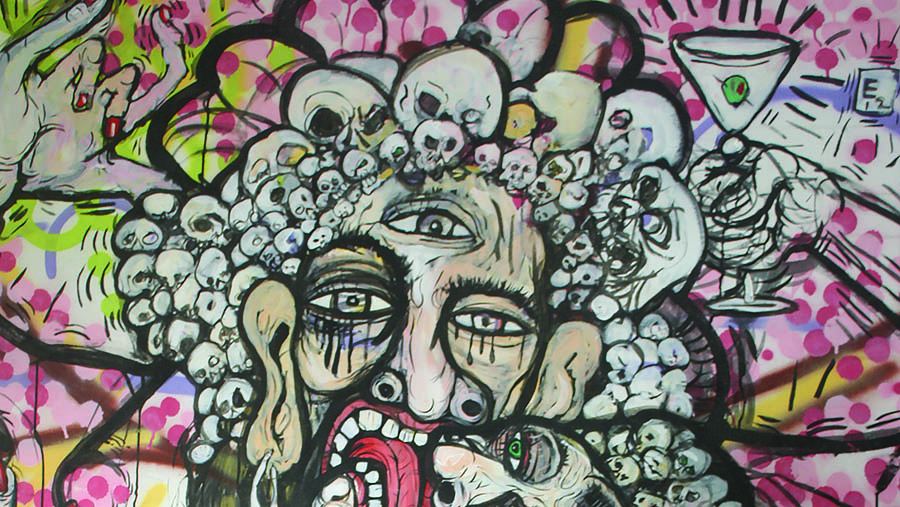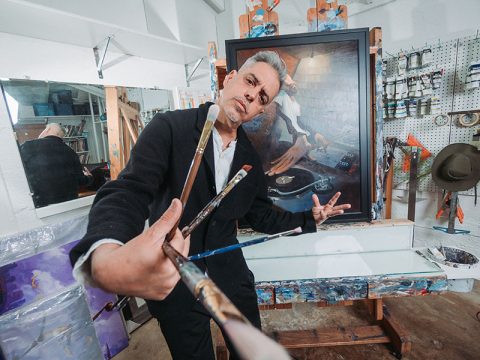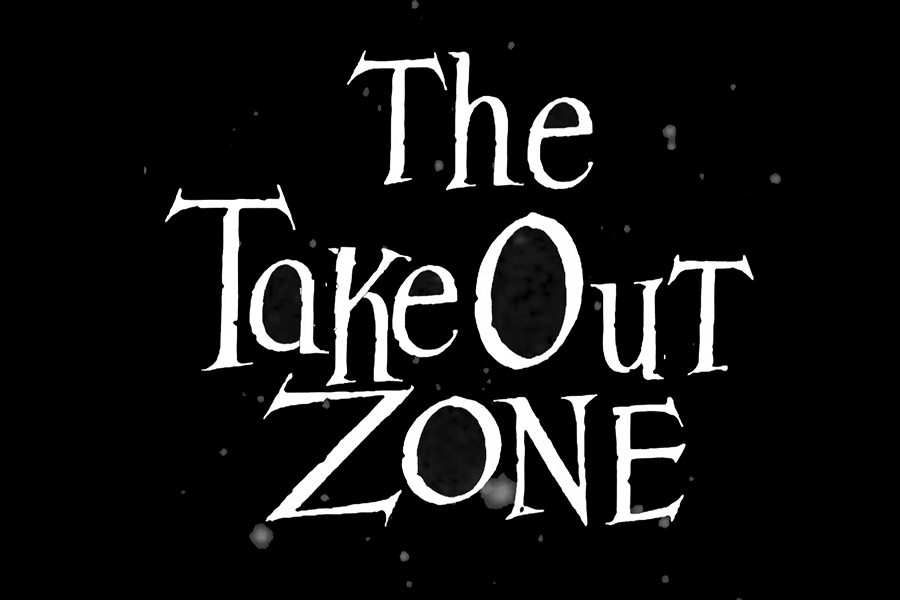
Sitting with DTLA artist/resident Emmeric Konrad at Pete’s Café on 4th and Main, it’s relevant to note the similarities between the two most iconic symbols of change within the Historic Core.
Before the stylish nightclubs, chic boutiques and exotic eateries was what this writer calls, “TheGRIT”, a dark, scary, enter at your own risk Downtown with a certain magnetic quality that drew you in and wouldn’t let go without a fight.
Konrad moved to DTLA in 1989 finding it a perfect place to indulge in creativity. With little or no compressions coupled with miles of historic scenery, he like property developer and Pete’s Café originator, Tom Gilmore, embraced the undeveloped area upon which to create and has since sparked an artists renaissance largely responsible for the areas success. All this came after accepting an opportunity from Gilmore to rent the dilapidated Regency Theater on Main Street, for about a buck a month.
Emmeric with black velvet jacket and military glasses sits with a devious smile spilling out entertaining comments and vicarious answers that keep all at the table laughing. His frosty white hair and painted black fingernails summon you to listen, as he seems to hold the answers with his entire existence to recapturing the art scene of Downtown’s past.
Not for soft ears, Konrad pulls no punches and enjoys a “not so sparkling unsoiled joke”, but the discipline to create and sell his works is easily recognizable by the concentrated squint of his crystal blue eyes. All three of them.
The Soul.
In most of his works commonalities; thick strokes, bright colors, body parts, and three eyes. The third eye from Asian mythology meant to represent the human consciousness or, the soul, is the inspiration for most of his paintings. Everyone from the homeless to the wealthy connects to him at random and he, in turn, spends his days drawing the sensation he receives from each person.
While others may find inspiration from various sources Konrad begins his creative process by just going to places, talking to people and sketching…Sometimes on paper, sometimes on restaurant napkins, it is never the person portrayed as they look but rather as they feel. As an artist Konrad believes it’s more important a portrait feel like the subject, not just look like one, which may explain the eerie feeling given off by Konrad’s works, as the viewer is thrown into a twisted altered reality where the soul and the body are exposed and can seen by all.
Gifted as a child his first art piece was a protest mural in his bedroom after mommie let a neighborhood girl ride his favored fire truck. In 3rd grade, Konrad was already making comic books, and at 12 was given a scholarship to attend a special school for gifted art students.
As a young adult he enjoyed Dungeons & Dragons and admits he was sort of a geek who liked to fight.
As a bad ass, receiving his BFA, he drove a 68 Harley at 25 and toted a shotgun, and a 57 magnum during the LA Riots, while protecting the women of Otis College from looters at MacArthur Park, only after he had joined the Marines. Scoring high on the admittance test he picked a job in avionics and finished top of the class in boot camp stating he thought the drill sergeants were “funny”.
Now at 50, Konrad has shown his works in Munich, Tokyo, Berlin, and completely sold out at his last show at District Gallery, (ArtsDistrict) but still has something special in wait, if he ever catches the person who’s been going around defacing the power boxes, recently commissioned by the City for local artists like Konrad as metal canvases. Surveillance tapes show the shadowy character painting over the 3rd eye on the power box and since Konrad has completely erased his box on 5th and Spring to make way for new work.
His major influences being abstract expressionists Willem de Kooning, Egon Schiele and Jackson Pollack, Konrad undeniably has a darker side. One of the most successful artist in Downtown, he contemplated one idea of wanting to paint devil wings opposite friend and fellow Downtown “Angel Wing” artist Colette Miller, but after a brief conversation with her changed his mind in fears that she would kill him if he did.
Monologue NOT Dialog.
Konrad’s use of charcoal, oil, acrylic, spray paint aren’t meant to produce “perfect art”, and Konrad likes it that way, saying “if you want perfect art, take a photo.”
“Art is a dialog, not a monolog it’s like the difference between
sex and masturbation”
Unstructured private parts, multiple arms, and third eyes can be creepy to some people. And that’s OK too according to Konrad. As conversations are aroused doing art that is meant to be seen, becomes an exchange, starting with the artist, then engaging the viewer who joins in to become just as much as part of the art as he is. The viewer in coming up with their own concepts many times change the way he even looks at the art… allowing him to often think…”Wow, I never really thought about that before”, and the reason why he feels so strongly that art is a dialog and not a monolog.
With age comes wisdom.
Konrad has long overcome his days as a starving artist contributing his success to mainly work, work, and more work. His is steadfast in his efforts incorporating an unwavering daily routine that includes, breakfast, a swim, walking the dogs, and creating for the remaining hours of each day.
He shares the same hours of work as his beautiful wife, Faye, who works in the corporate sector; 6:30am to 6:00pm except in the days before a show, where its very possible for him to put in 23 consecutive hours of overtime.
Konrad’s advice for young artists is to simply go out and meet people. He states it’s seldom that he submits his work for acceptance to galleries as he is often invited. But most important, being an artist is also being a supporter of the arts and one should take time to attend art shows and make new connections as much as possible.
Artists of DTLA will receive the proper credit due for helping to rejuvenate “TheGRIT” and Konrad is sure to remain, solidifying his place in Downtown history and producing thought and soul provoking works readily available for sale and the public eye…or should we say “eyes”.
EMMERIC KONRAD – MM IN TRIBUTE TO THE MEMPHIS 3

Artist Statement:
Inspired by the West Memphis 3. Three high school students who were accused and imprisoned for the supposed murders of three very young boys. There was no physical evidence, the biggest crime against them was they were “strange”, wore black and listened to heavy metal. At the time I was asked to take part in the fundraiser for their defense along with Marylin Manson and Chad Robinson.
Focusing on the wrongly accused boys in prison, I wanted to remind everyone that there were six victims of this horrible crime so I made portraits of the three murdered boys. I used the last school photos as reference and since their bodies had been found in a creek bed I went to the LA River to find the wood used for the Tryptic.
It was the most difficult painting I had ever done.












